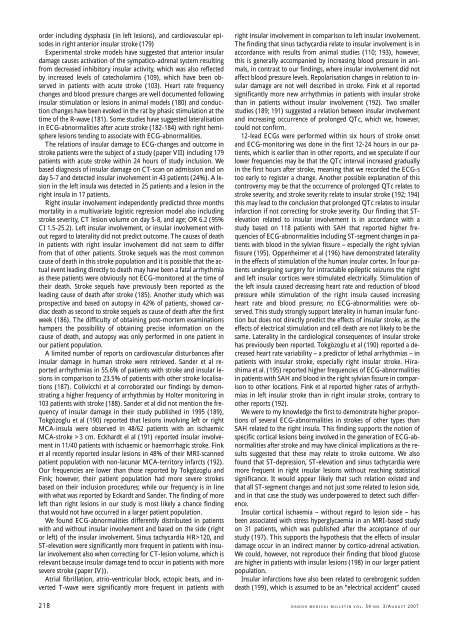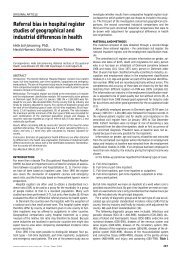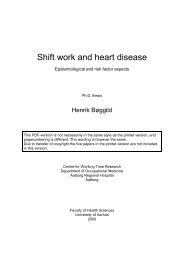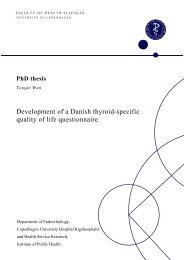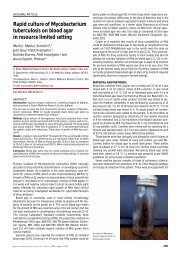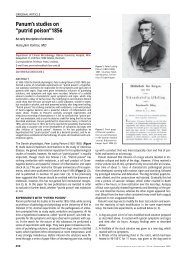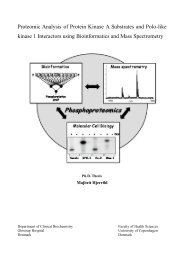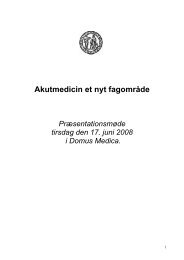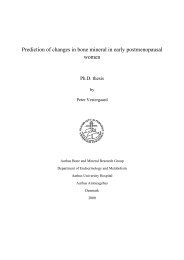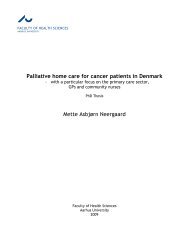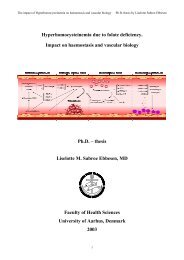Acute stroke â a dynamic process - Danish Medical Bulletin
Acute stroke â a dynamic process - Danish Medical Bulletin
Acute stroke â a dynamic process - Danish Medical Bulletin
Create successful ePaper yourself
Turn your PDF publications into a flip-book with our unique Google optimized e-Paper software.
order including dysphasia (in left lesions), and cardiovascular episodes<br />
in right anterior insular <strong>stroke</strong> (179)<br />
Experimental <strong>stroke</strong> models have suggested that anterior insular<br />
damage causes activation of the sympatico-adrenal system resulting<br />
from decreased inhibitory insular activity, which was also reflected<br />
by increased levels of catecholamins (109), which have been observed<br />
in patients with acute <strong>stroke</strong> (103). Heart rate frequency<br />
changes and blood pressure changes are well documented following<br />
insular stimulation or lesions in animal models (180) and conduction<br />
changes have been evoked in the rat by phasic stimulation at the<br />
time of the R-wave (181). Some studies have suggested lateralisation<br />
in ECG-abnormalities after acute <strong>stroke</strong> (182-184) with right hemisphere<br />
lesions tending to associate with ECG-abnormalities.<br />
The relations of insular damage to ECG-changes and outcome in<br />
<strong>stroke</strong> patients were the subject of a study (paper VII) including 179<br />
patients with acute <strong>stroke</strong> within 24 hours of study inclusion. We<br />
based diagnosis of insular damage on CT-scan on admission and on<br />
day 5-7 and detected insular involvement in 43 patients (24%). A lesion<br />
in the left insula was detected in 25 patients and a lesion in the<br />
right insula in 17 patients.<br />
Right insular involvement independently predicted three months<br />
mortality in a multivariate logistic regression model also including<br />
<strong>stroke</strong> severity, CT lesion volume on day 5-8, and age; OR 6.2 (95%<br />
CI 1.5-25.2). Left insular involvement, or insular involvement without<br />
regard to laterality did not predict outcome. The causes of death<br />
in patients with right insular involvement did not seem to differ<br />
from that of other patients. Stroke sequels was the most common<br />
cause of death in this <strong>stroke</strong> population and it is possible that the actual<br />
event leading directly to death may have been a fatal arrhythmia<br />
as these patients were obviously not ECG-monitored at the time of<br />
their death. Stroke sequels have previously been reported as the<br />
leading cause of death after <strong>stroke</strong> (185). Another study which was<br />
prospective and based on autopsy in 42% of patients, showed cardiac<br />
death as second to <strong>stroke</strong> sequels as cause of death after the first<br />
week (186). The difficulty of obtaining post-mortem examinations<br />
hampers the possibility of obtaining precise information on the<br />
cause of death, and autopsy was only performed in one patient in<br />
our patient population.<br />
A limited number of reports on cardiovascular disturbances after<br />
insular damage in human <strong>stroke</strong> were retrieved. Sander et al reported<br />
arrhythmias in 55.6% of patients with <strong>stroke</strong> and insular lesions<br />
in comparison to 23.5% of patients with other <strong>stroke</strong> localisations<br />
(187). Colivicchi et al corroborated our findings by demonstrating<br />
a higher frequency of arrhythmias by Holter monitoring in<br />
103 patients with <strong>stroke</strong> (188). Sander et al did not mention the frequency<br />
of insular damage in their study published in 1995 (189),<br />
Tokgözoglu et al (190) reported that lesions involving left or right<br />
MCA-insula were observed in 48/62 patients with an ischaemic<br />
MCA-<strong>stroke</strong> >3 cm. Eckhardt el al (191) reported insular involvement<br />
in 11/40 patients with ischaemic or haemorrhagic <strong>stroke</strong>. Fink<br />
et al recently reported insular lesions in 48% of their MRI-scanned<br />
patient population with non-lacunar MCA-territory infarcts (192).<br />
Our frequencies are lower than those reported by Tokgözoglu and<br />
Fink; however, their patient population had more severe <strong>stroke</strong>s<br />
based on their inclusion procedures; while our frequency is in line<br />
with what was reported by Eckardt and Sander. The finding of more<br />
left than right lesions in our study is most likely a chance finding<br />
that would not have occurred in a larger patient population.<br />
We found ECG-abnormalities differently distributed in patients<br />
with and without insular involvement and based on the side (right<br />
or left) of the insular involvement. Sinus tachycardia HR>120, and<br />
ST-elevation were significantly more frequent in patients with insular<br />
involvement also when correcting for CT-lesion volume, which is<br />
relevant because insular damage tend to occur in patients with more<br />
severe <strong>stroke</strong> (paper IV)).<br />
Atrial fibrillation, atrio-ventricular block, ectopic beats, and inverted<br />
T-wave were significantly more frequent in patients with<br />
right insular involvement in comparison to left insular involvement.<br />
The finding that sinus tachycardia relate to insular involvement is in<br />
accordance with results from animal studies (110; 193), however,<br />
this is generally accompanied by increasing blood pressure in animals,<br />
in contrast to our findings, where insular involvement did not<br />
affect blood pressure levels. Repolarisation changes in relation to insular<br />
damage are not well described in <strong>stroke</strong>. Fink et al reported<br />
significantly more new arrhythmias in patients with insular <strong>stroke</strong><br />
than in patients without insular involvement (192). Two smaller<br />
studies (189; 191) suggested a relation between insular involvement<br />
and increasing occurrence of prolonged QTc, which we, however,<br />
could not confirm.<br />
12-lead ECGs were performed within six hours of <strong>stroke</strong> onset<br />
and ECG-monitoring was done in the first 12-24 hours in our patients,<br />
which is earlier than in other reports, and we speculate if our<br />
lower frequencies may be that the QTc interval increased gradually<br />
in the first hours after <strong>stroke</strong>, meaning that we recorded the ECG-s<br />
too early to register a change. Another possible explanation of this<br />
controversy may be that the occurrence of prolonged QTc relates to<br />
<strong>stroke</strong> severity, and <strong>stroke</strong> severity relate to insular <strong>stroke</strong> (192; 194)<br />
this may lead to the conclusion that prolonged QTc relates to insular<br />
infarction if not correcting for <strong>stroke</strong> severity. Our finding that STelevation<br />
related to insular involvement is in accordance with a<br />
study based on 118 patients with SAH that reported higher frequencies<br />
of ECG-abnormalities including ST-segment changes in patients<br />
with blood in the sylvian fissure – especially the right sylvian<br />
fissure (195). Oppenheimer et al (196) have demonstrated laterality<br />
in the effects of stimulation of the human insular cortex. In four patients<br />
undergoing surgery for intractable epileptic seizures the right<br />
and left insular cortices were stimulated electrically. Stimulation of<br />
the left insula caused decreasing heart rate and reduction of blood<br />
pressure while stimulation of the right insula caused increasing<br />
heart rate and blood pressure; no ECG-abnormalities were observed.<br />
This study strongly support laterality in human insular function<br />
but does not directly predict the effects of insular <strong>stroke</strong>, as the<br />
effects of electrical stimulation and cell death are not likely to be the<br />
same. Laterality in the cardiological consequences of insular <strong>stroke</strong><br />
has previously been reported. Tokgözoglu et al (190) reported a decreased<br />
heart rate variability – a predictor of lethal arrhythmias – in<br />
patients with insular <strong>stroke</strong>, especially right insular <strong>stroke</strong>. Hirashima<br />
et al. (195) reported higher frequencies of ECG-abnormalities<br />
in patients with SAH and blood in the right sylvian fissure in comparison<br />
to other locations. Fink et al reported higher rates of arrhythmias<br />
in left insular <strong>stroke</strong> than in right insular <strong>stroke</strong>, contrary to<br />
other reports (192).<br />
We were to my knowledge the first to demonstrate higher proportions<br />
of several ECG-abnormalities in <strong>stroke</strong>s of other types than<br />
SAH related to the right insula. This finding supports the notion of<br />
specific cortical lesions being involved in the generation of ECG-abnormalities<br />
after <strong>stroke</strong> and may have clinical implications as the results<br />
suggested that these may relate to <strong>stroke</strong> outcome. We also<br />
found that ST-depression, ST-elevation and sinus tachycardia were<br />
more frequent in right insular lesions without reaching statistical<br />
significance. It would appear likely that such relation existed and<br />
that all ST-segment changes and not just some related to lesion side,<br />
and in that case the study was underpowered to detect such difference.<br />
Insular cortical ischaemia – without regard to lesion side – has<br />
been associated with stress hyperglycaemia in an MRI-based study<br />
on 31 patients, which was published after the acceptance of our<br />
study (197). This supports the hypothesis that the effects of insular<br />
damage occur in an indirect manner by cortico-adrenal activation.<br />
We could, however, not reproduce their finding that blood glucose<br />
are higher in patients with insular lesions (198) in our larger patient<br />
population.<br />
Insular infarctions have also been related to cerebrogenic sudden<br />
death (199), which is assumed to be an “electrical accident” caused<br />
218 DANISH MEDICAL BULLETIN VOL. 54 NO. 3/AUGUST 2007


